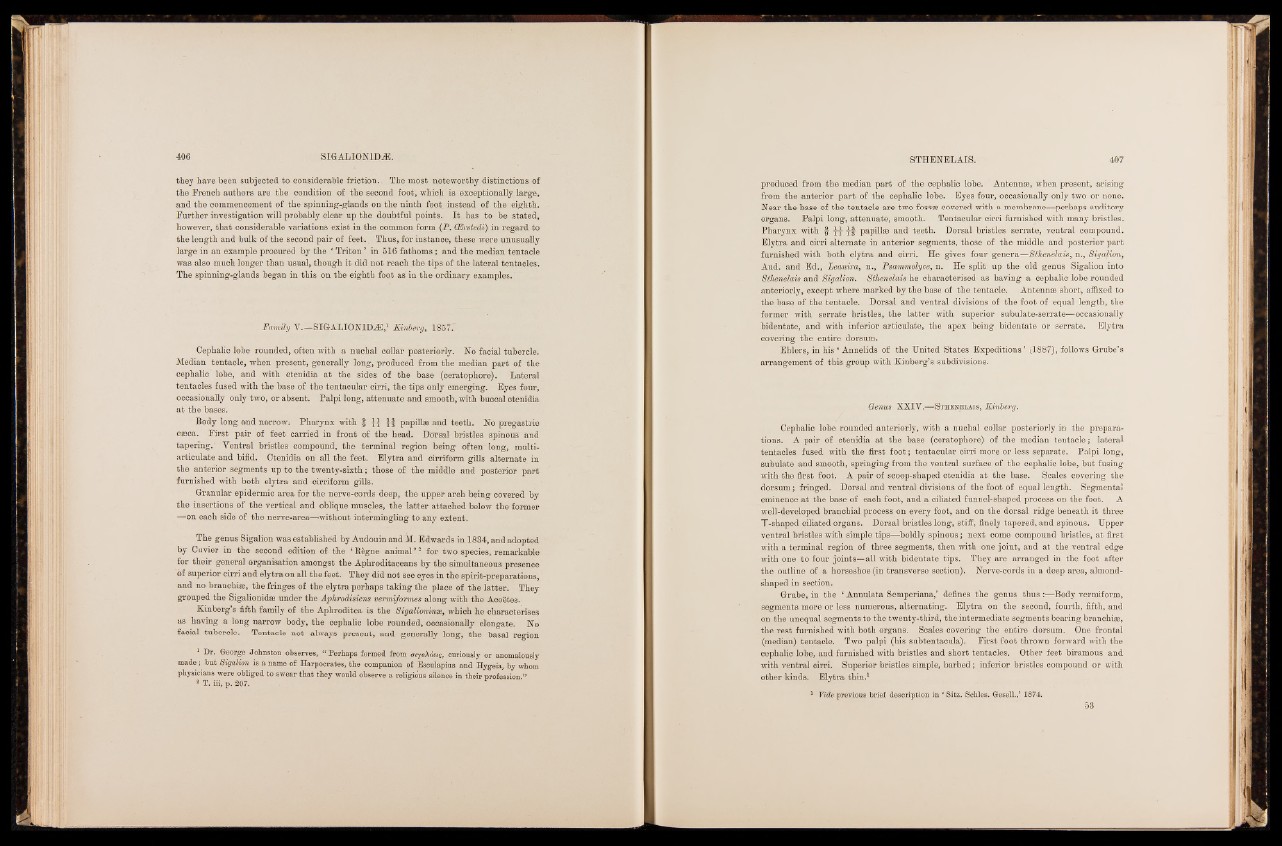
they have been subjected to considerable friction. The most noteworthy distinctions of
the French authors are the condition of the second foot, which is exceptionally large,
and the commencement of the spinning-glands on the ninth foot instead of the eighth.
Further investigation will probably clear up the doubtful points. I t has to be stated,
however, that considerable variations exist in the common form (P. CEh'stedi) in regard to
the length and bulk of the second pair of feet., Thus, for instance, these were unusually
large in an example procured by the ‘ Triton ’ in 516 fathoms ; and the median tentacle
was also much longer than usual, though it did not reach the tips of the lateral tentacles.
The spinning-glands began in this on the eighth foot as in the ordinary examples.
Family Y.—SIG-ALIONID^E,1 Kinberg, 1857.
Cephalic lobe rounded, often with a nuchal collar posteriorly. No facial tubercle.
Median tentacle, when present, generally long, produced from the median part of the
cephalic lobe, and with ctenidia at the sides of the base (ceratophore). Lateral
tentacles fused with the base of the tentacular cirri, the tips only emerging. Eyes four,
occasionally only two, or absent. Palpi long, attenuate and smooth, with buccal ctenidia
at the bases.
Body long and narrow. Pharynx with f xi- I f papillse and teeth. No pregastric
caaca. First pair of feet carried in front of the head. Dorsal bristles spinous and
tapering.' Yentral bristles compound, the terminal region being often- long, multi-
articulate and bifid. Ctenidia on all the feet. Elytra and cirriform gills alternate in
the anterior segments up to the twenty-sixth; those of the middle and posterior part
furnished with both elytra and cirriform gills.
Granular epidermic area for the nerve-cords deep, the upper arch being covered by
the insertions of the vertical and oblique muscles, the latter attached below the former
—on each side of the nerve-area—without intermingling to any extent.
The genus Sigalion was established by Audouin and M. Edwards in 1884, and adopted
by Cuvier in the second edition of the ‘K&gne animal’2 for two species, remarkable
for their general organisation amongst the Aphroditaceans by the simultaneous presence
of superior cirri and elytra on all the feet. They did not see eyes in the spirit-preparations,
and no branchias, the fringes of the elytra perhaps taking the place of the latter. They
grouped the Sigalionidaa under the Aphrodisiens vermiformes along with the Acoetes.
Kinberg s fifth family of the Aphroditea is the Sigalioni/nse, which he characterises
as having a long narrow body, the cephalic lobe rounded, occasionally elongate. No
facial tubercle. Tentacle not always present, and generally long, the basal region
Dr. George «Johnston observes, “ Perhaps formed from myaXdeig, curiously or anomalously
made; but Sigalion is a name of Harpocrates, the companion of Esculapius and Hygeia, by whom
physicians were obliged to swear that they would observe a religious silence in their profession.”
2 T. iii, p. 207.
produced from the median part of the cephalic lobe. Antennas, when present, arising
from the anterior part of the cephalic lobe. Eyes four, occasionally only two or none.
Near the base of the tentacle are two fossae covered with a membrane—perhaps auditory
organs. Palpi long, attenuate, smooth. Tentacular cirri furnished with many bristles.
Pharynx with f it I f papillae and teeth. Dorsal bristles serrate, ventral compound.
Elytra and cirri alternate in anterior segments, those of the middle and posterior part
furnished with both elytra and cirri. He gives four genera—Sthenelais, n., Sigalion,
Aud. and Ed., Leanvra, n., Psammolyce, n. He split up the old genus Sigalion into
Sthenelais and Sigalion. Sthenelais he characterised as having a cephalic lobe rounded
anteriorly, except where marked by the base of the tentacle. Antennas short, affixed to
the base of the tentacle. Dorsal and ventral divisions of the foot of equal length, the
former with serrate bristles, the latter with superior subulate-serrate—occasionally
bidentate, and with inferior articulate, the apex being bidentate or serrate. Elytra
covering the entire dorsum.
Ehlers, in his * Annelids of the United States Expeditions ’ (1887), follows G-rube’s
arrangement of this group with Kinberg’s subdivisions.
Genus XXIY.—Sthenelais, Kinberg.
Cephalic lobe rounded anteriorly, with a nuchal collar posteriorly in the preparations.
A pair of ctenidia at the base (ceratophore) of the median tentacle; lateral
tentacles fused with the first foot; tentacular cirri more or less separate. Palpi long,
subulate and smooth, springing from the ventral surface of the cephalic lobe, but fusing
with the first foot. A pair of scoop-shaped ctenidia at the base. Scales covering the
dorsum; fringed. Dorsal and ventral divisions of the foot of equal length. Segmental
eminence at the base of each foot, and a ciliated funnel-shaped process on the foot. A
well-developed branchial process on every foot, and on the dorsal ridge beneath it three
T-shaped ciliated organs. Dorsal bristles long, stiff, finely tapered, and spinous. Upper
ventral bristles with simple tips—boldly spinous; next come compound bristles, at first
with a terminal region of three segments, then with one joint, and at the ventral edge
with one to four joints—all with bidentate tips. They are arranged in the foot after
the outline of a horseshoe (in transverse section). Nerve-cords in a deep area, almond-
shaped in section.
Grube, in the ‘ Annulata Semperiana,’ defines the genus thus :—Body vermiform,
segments more or less numerous, alternating. Elytra on the second, fourth, fifth, and
on the unequal segments to the twenty-third, the intermediate segments bearing branchiae,
the rest furnished with both organs. Scales covering the entire dorsum. One frontal
(median) tentacle. Two palpi (his subtentacula). First foot thrown forward with the
cephalic lobe, and furnished with bristles and short tentacles. Other feet biramous and
with ventral cirri. Superior bristles simple, barbed; inferior bristles compound or with
other kinds. Elytra thin.1
1 Vide previous brief description in ‘ Sitz. Schles. Gesell.,’ 1874.